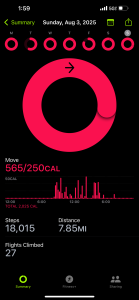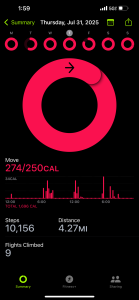Walking 10,000 steps a day has been a trending wellness goal for years — from fitness tracker milestones to TikTok step challenges to the quiet check-ins we’ve shared with friends about our daily counts. As someone who already loves walking, I decided to commit to 10k steps a day for one week to see what would shift — in my body, in my mind, and in my routines.
This article includes:
- 10k steps a day
- walking
- how many steps a day
- how far is 10,000 steps
- benefits of walking
Interested in more wellness tips? Check out Wellness Tips for Beginners: A Gentle Guide to Starting Your Journey.
Here’s what I discovered, and how you can adapt it to bring more movement and mindfulness into your own days.
I’m not a medical or health professional — this is simply my personal experience. Please check with a qualified professional before making any major changes to your exercise routine.
Let’s get to it!
Walking 10k Steps a Day: What I Learned After One Week
Quick Facts
-
10,000 steps ≈ 4.5–5 miles for most adults (varies with stride length).
-
Walking at a brisk pace can increase heart rate and support cardiovascular health.
-
Consistent movement improves energy, mood, and mental clarity.
-
Splitting walks into morning and evening makes the goal more approachable.
-
You don’t have to hit 10k steps every day to feel the benefits.
My One-Week 10k Step Experiment
I didn’t just walk more — I designed a rhythm that worked with my life. That meant morning walks before work when the city was still quiet, evening walks after work when I needed to decompress, and a longer weekend walk where I let myself wander into neighborhoods I rarely visit. Daily chores filled in the rest without me even noticing.
How I Reached 10k Steps a Day
-
Morning walks before work: ~4k steps
-
Evening walks after work: ~5k steps
-
Weekend long walk: ~12k+ steps, exploring new neighborhoods
-
Daily chores: ~1k steps without planning
Breaking it into smaller pieces felt far less intimidating than one long stretch.
What surprised me most was how much this routine became a grounding ritual. Those morning walks felt like a gentle warm-up for my mind — time to breathe, watch the light change, and set an intention for the day ahead. Evenings were for letting go of whatever had built up, each step releasing a little more tension. It became less about chasing a number and more about honoring these two pauses in my day — little bookends of movement, fresh air, and reflection.
Benefits I Noticed
1. Higher Mood and Energy
After morning walks, I felt more awake and uplifted — my mind clear, my body warm. The positive shift stayed with me through the day.
2. Mental Clarity
Walking offered space for thoughts to settle. I returned to my desk with fresh ideas and a lighter outlook.
3. Physical Fitness
A brisk pace got my heart pumping and my breathing deeper — enough to feel the strength and energy building without overexertion.
4. Meditative Routine
The steady rhythm of my steps felt meditative — time just for myself, where I could let go of my thoughts and simply move. After a while, the walking became almost automatic, as if my body knew the way without me having to think about it.
5. Better Sleep
By week’s end, my sleep each night felt deeper and more restful. I fell asleep faster and woke up feeling more ready to start the day.
6. Improved Digestion
Especially after evening walks, I noticed less bloating, less gas, and fewer feelings of heaviness. Gentle movement after dinner seemed to support better digestion and keep discomfort away for the rest of the day.
Why You Don’t Need 10k Steps Every Day
10,000 steps can be motivating, but research shows that anywhere from 2,500–8,000 steps daily already offers meaningful benefits for heart health, longevity, and mood.
The key is consistency — weaving movement into your everyday life in a way that feels nourishing and sustainable.
My Key Takeaways
-
Consistency matters more than the number — aim for daily movement you enjoy.
-
Split walks into shorter sessions for a more approachable routine.
-
Walking at a brisk pace offers real fitness benefits.
-
The ritual of walking can be meditative and grounding.
-
Step goals build discipline and self-confidence.
-
Better sleep quality can be a natural side effect.
-
Adjust your step count to fit your lifestyle and energy.
Final Thoughts on 10k Steps a Day
Committing to a step goal builds more than physical endurance — it’s an exercise in showing up for yourself. For me, the consistency felt like an anchor: time in my day that was just for me, away from screens, noise, and demands. It strengthened my confidence, not just in my ability to meet a goal, but in my ability to keep a promise to myself.
Enjoyed this article? Next, check out Is Non-Toxic a Myth?.








